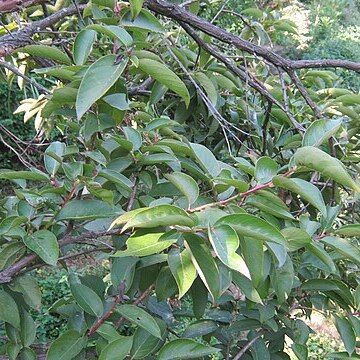Small, often crooked tree 4-6(-8) m high, trunk up to 10 cm ø, or bushy spreading shrub, occasionally epiphytic, with blackish brown or grey, deeply longitudinally fissured fibrous bark. Young branches terete, at first whitish puberulous, afterwards becoming glabrous and blackish. Leaves (in Mal.) evergreen, ovate, rather variable and sometimes ovate-elliptic or ovate-oblong (Mal.), apex short-acuminate, +-acute, base broad-attenuate or mostly rounded, sometimes subcordate, thinly coriaceous, firm, dark glossy green and glabrous above except the midrib, rusty-pubescent at least initially beneath at the midrib and nerves, glabrescent, edge very slightly recurved, (5-)6-10(-l 5) by (3-)4-5.5(-7) cm, midrib flat above, prominent beneath, nerves (8-)10-15 pairs, spreading, ± parallel, slightly curved upwards near the edge, sharply prominent beneath, veins ± transverse, reticulation dense, minutely or hardly prominent on both faces; petiole puberulous, 3—10(-12) mm. Racemes by suppression or early fall of the leaves sometimes forming a terminal false panicle, (5-)6-15(-20) cm long, +-pubescent. Flowers close together, secund, drooping. Bract linear or lanceolate, acute, caducous, 2.5-4 mm. Bracteoles small, linear-oblong. Pedicels slender, pubescent, 2-3 mm. Calyx lobes triangular-lanceolate or ovate, ± acute, ± pubescent, c. 2 mm. Corolla early caducous, narrowly elongate-ovoid to urceolate-cylindric, white to very pale cream, pubescent outside, puberulous within, 13 by 5 mm in fresh, (5-)7-9 mm in dry specimens. Stamens half as long as the corolla; filaments white, woolly at the broad base, with 2 divaricate setaceous appendices near the apex; anthers ovoid, 1-1.5 mm. Disk lobes thick, deltoid, obtuse, alternating with the 5 faint ribs of the ovary. Ovary subglobose, pubescent; style cylindric, ± as long as the corolla. Capsule globose, 4-5 mm ø, glabrous, supported by the persistent calyx.
More
Shrubs or trees, deciduous or evergreen, 1–4 m tall. Twigs glabrous or pubescent. Buds narrowly ovoid, (1–)3–9(–11.5) mm, glabrous. Petiole 4–9 mm, glabrous or pubescent; leaf blade ovate, narrowly to broadly elliptic, lanceolate, or suborbicular, 3–20 × 2–12 cm, papery to thinly leathery, both surfaces ± with white or brown hairs, rarely abaxially densely white villous on midvein or subglabrous, veins prominently raised to slightly depressed or nearly obscure, base obtuse, cuneate, or sometimes cordate, apex acuminate. Inflorescences 5–20 cm, pubescent; lower 1–3(or 4) bracts leaflike or not. Pedicel 2–10 mm, densely pubescent. Calyx lobes oblong or triangular, 2–6 mm, densely or sometimes sparsely pubescent. Corolla tubular, 8–11 mm, abaxially densely pubescent; lobes ca. 1 mm. Filaments 5–8 mm, pilose, with 2 spurs at apex. Ovary glabrous or pubescent. Capsule globose or ovoid, 3–5 mm in diam., with thick sutures or not, glabrous to densely pubescent. Fl. May–Jun, fr. Jul–Sep. 2n = 24*.
A shrub. It grows 1-4 m tall. The leaves are narrowly oval and 3-20 cm long by 2-12 cm wide. They are hairy. The flowering shoots are 5-20 cm long.


